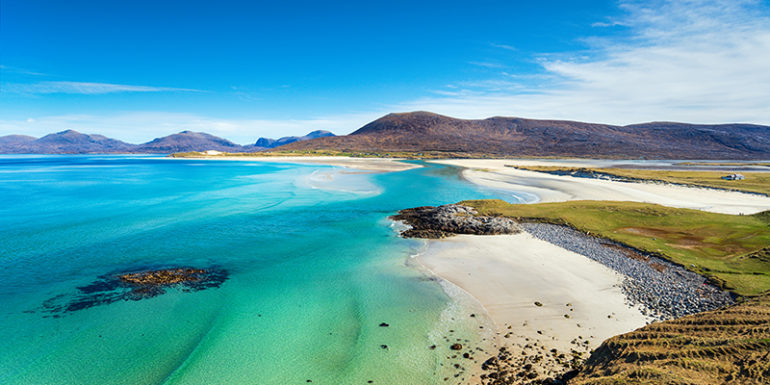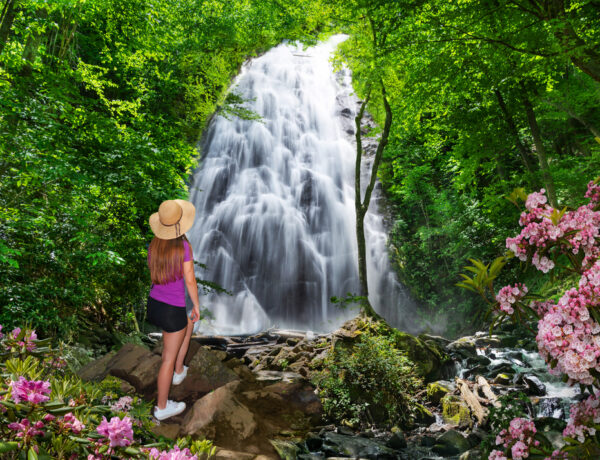During the past two weeks I’ve been exploring some of Great Britain’s most remote regions: Scotland’s Hebrides Islands. At times without a mobile signal, let alone Wifi, I was forced to relax and experience the islands for what they are: each has a different character, but they all feel like you’ve landed on a planet somewhere far away in outer space. Definitely a very different experience than any of the Edinburgh trips I recently mentioned.
Depending on how you count, Scotland has almost 800 islands off of its coast. That would make for an awfully long article! However, I’ve grouped the most popular and well-known islands together to give you some ideas, tips, and recommendations for visiting the Hebrides Islands. We’ll roughly travel from north to south as we skirt along the west coast of the mainland.
Lewis and Harris

Lewis and Harris (actually a single island, geographically) make up the largest land mass in the area of Hebrides Islands. Harris makes up the southern portion of this landmass and is known for having some of Great Britain’s most beautiful beaches – a shame it’s often a bit misty and the water is cold. Once you cross the ‘border’ into Lewis, the larger northern section, you soon realise why there are two naming distinctions here – Lewis looks as if you have driven over into another planet. There are zero trees (due to the Vikings and other man-made disruptions), and the landscape is strewn with rocks and barren hills. It’s a stark place and very striking.
The tourism highlight for me is the Standing Stones of Callanish. These stones are nearly twice as old as Stonehenge yet not as well know, and consist of the main circle pictured above, as well as two other circles nearby. Walking through Callanish is like walking through an enormous magnet – it’s the most powerful of any megalithic site I have ever been to.
North Uist, South Uist, and Barra

The Uist (prounced “you-ist”) islands are a great place to go if you want some Hebrides Islands tranquillity. There are large expanses of just nothing, and even the larger settlements are just wee villages. The big attraction is just to the south of the Uists, on Barra island, which is the world’s only beach airport. Yup, that’s it above. The flights land depending on the tide. If this sounds like a must-have experience for you, do it soon – the changing ecology of the landscape, as well the lack of a replacement for the aircraft that services this route, means this weird wonder might not last forever.
Skye
Skye has a bridge to the mainland, which I think makes it one of the most popular of the Hebrides Islands. It’s also one of the most crowded – making driving on the islands many single track roads nothing short of a nightmare, so be sure to give yourself plenty of time to get around. The coast road along the northeast coast offers lots of great stops, such as this wonderful viewpoint at Kilt Rock. Don’t miss the hike down (and by down I mean DOWN) to the lighthouse on Neist Point – though this drive is a pretty long one. And of course, you’ll find plenty of things to do around the island’s main town, Portree, with it’s colourful harbour houses.
Canna, Rhum, Muck and Eigg

These funny-named Hebrides Islands make up what are called the Small Isles, kind of a funny thing to say considering there are a lot of similarly-sized island around all of the west coast. These islands have some of the earliest evidence of human occupation in all of Scotland, so you’ll find lots of interesting ruins, relics, and remnants of history gone past. Most of the land (and the roads) here are privately owned, meaning you aren’t allowed to bring a car here, but its easy to walk around to everything you want to see.
Coll and Tiree

Tiree is actually a hidden suntrip in the Hebrides Islands, with many more hours of sunshine than its neighbours. These islands have some beautiful beaches and a lot of great examples of traditional architecture, such as blackhouses and traditional thatched roofs. There are also some unique stones that the ancients said had mystical properties.
Mull, Iona, and Staffa
Mull is one of the larger of the Hebrides Islands, and despite this it still only has one main road. The main city on mull is Tobermory, a beautiful fishing village with colourful houses like in Portree on Skye. At the other end of Mull (which doesn’t have much in between, except just beautiful scenery), you can catch the short ferry hop to Iona, another small island where you’ll find the beautiful Iona Abbey, established by St Columba in 563, making it one of Western Europe’s oldest religious sites, and many of the Scottish kings had their religious focus out here in the west coast.
If the weather is ok, be sure to take the 30 minute boat trip out to Staffa Island (from Iona). This unusual create is an island made entirely of hexagonal basalt, so it is similar to what you’d think aliens would build if they were looking to build an island in the Atlantic. You can hike around the top (watch for those cliff edges – no railing), or walk into Fingal’s Cave and listen to the waves beat against the inside of mother nature’s own cathedral.
Islay, Jura and Gigha
Whisky-loves will need no introduction to these famous Hebrides Islands – many brochures and magazines will feature the Paps of Jura (shown above) as one of the Hebridean icons. You can register with the island of Jura and get a free dram of whisky when you visit, though I warn you, this is one of my two favourite whiskies, so one dram might not be enough. The whisky spends a lot of time in saltwater, so it has a salty, refreshing taste to it.
Islay (pronounced ”eye-la”) also is whisky country, though this whisky spends a lot of time in peat, so it has a very (very!) smoky flavour. You’ll either love it or hate it. But definitely worth visiting to find out.
Getting Around
If you haven’t been to the Hebrides Islands before and are planning a trip, please heed some of my advice, because in this part of the world, a little bit of planning goes a heck of a long way.
- Ferries: Ferries can quickly be full in summer, and many routes only have one or two ferries a day. Book ahead whenever possible, unless you want to be stuck somewhere. Ferries can also be cancelled due to high winds/low tides/bad weather. This doesn’t happen often, but it does happen, so keep that in mind.
- Single Track Roads: Many islands are still on the single track road system. On the ferries you’ll be able to pick up a brochure the explains this system in detail, but I mention it so you aren’t caught off guard. On most islands this isn’t a problem because of the little traffic, but in some places (like Skye), it can be a real downside. Passing places are frequent so you just have to pull over and let traffic pass, but on narrow roads and cliffs, this can be daunting.
- Weather: Remember, this is the wild Atlantic ocean. Sturdy footwear and waterproof clothing makes for a better holiday in the Hebrides Islands, especially since many attractions and sights are outdoors.
Have you been to the Hebrides Islands? Got a story or tip you’d like to share?
Photos by author except Barra (kevinzim), Rhum (snappybex), Tiree (atomicjeep), Jura (andyspictures), Ferry (Chris_DB).





No Comments